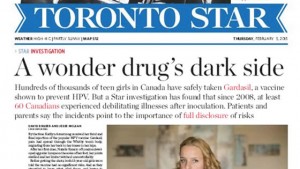 Fifteen days after publishing a widely-criticized article linking anecdotal health problems to the HPV vaccine Gardasil, the Toronto Star has issued a retraction.
Fifteen days after publishing a widely-criticized article linking anecdotal health problems to the HPV vaccine Gardasil, the Toronto Star has issued a retraction.
The Page 1 story, “A wonder drug’s dark side,” was full of health horror stories from women who became sick “sometime after” the vaccine, as the retraction notes – twitching limbs, feeding tubes, even death. Each of these stories came from the Vaccine Adverse Event Reporting System, a public database of anecdotes maintained by the U.S. government to help monitor rare side effects that might emerge when the vaccine is given to millions of people.
In mining this database of self-reported illness, the Star failed to give equal weight to the large body of scientific evidence that says Gardasil has very low rates of adverse effects and a huge public health benefit. The publisher’s note both acknowledges the criticism and explains where the story went wrong:
The article focused on several young women who had grown sick sometime after taking the anti-papillomavirus vaccine Gardasil.
The story included the caveat that none of these instances had been conclusively linked to the vaccine.
However, the weight of the photographs, video, headlines and anecdotes led many readers to conclude the Star believed its investigation had uncovered a direct connection between a large variety of ailments and the vaccine.
Some doctors and public health officials were troubled by the story treatment and by the lack of reference to the many studies which conclude the risks of Gardasil are low.
All major studies conducted after widespread inoculations began in 2006 have concluded the risks posed by Gardasil are no greater than those identified in the trial period before the vaccine was licensed and accepted for widespread use.
This publisher’s note, along with public editor Kathy English’s criticism of the paper’s reporting and an opinion piece signed by dozens of doctors, are welcome antidotes to other Star editors’ and writers’ defensive responses to those concerned about the public health implications of a story that very well might scare women off from a life-saving vaccine.
Two weeks is a long time for a scare-mongering story with little scientific evidence to stay online, and some, including physician assistant and medical journalist Maureen Taylor, found this sentence from the publisher’s note troubling:
We remain committed to this line of reporting.
And as Forbes’ Matthew Herper put it:
Bravo, but too much defensiveness in correction.
We, too, commend the Toronto Star for making the move, with caveats. It probably would have been better to leave the story posted, with an impossible-to-miss note at the top, than make it disappear. That, if this were a scientific journal, would be consistent with guidelines from the Committee on Publication Ethics.
And we should also note that whatever its imperfections, how the Star handled this makes it stand out in the media. Compared to scientific publishing, newspaper retractions are incredibly uncommon. Top journals run several retractions a year. Newspapers retract much more rarely, often under public or legal pressure. Even then they generally run a correction rather than a retraction.
Still, hopefully the notice, along with the pieces they published that criticized “A wonder drug’s dark side,” can start undoing some of the damage the article may have caused.
What they really meant:
“We remain strongly committed to having unqualified people writing stories without any expert advice.”
Any anti-vaccine folks who still need a fix with vaccine fear mongering need go no further than MDPI’s journal Entropy. There is an article published in this journal entitled “Empirical Data Confirm Autism Symptoms Related to Aluminum and Acetaminophen Exposure.” It is here: http://www.mdpi.com/1099-4300/14/11/2227
Here’s one sentence from the paper’s abstract: “Our results provide strong evidence supporting a link between autism and the aluminum in vaccines.” The article was published in 2012.
Seneff’s entire shtick is mining for spurious correlations and failing to understand statistics.
Here’s another sentence from the paper’s abstract:
“This paper investigates word frequency patterns…”
That’s a pretty huge conclusion to draw from “frequency patterns”. The paper’s methodology is laughable.
The sentence before the one cited may provide evidence of a link in the VAERS between words related to aluminum and autism but not necessarily a link between aluminum and autism and certainly not a causal relationship: “This paper investigates word frequency patterns in the U.S. CDC Vaccine Adverse Events Reporting System (VAERS) database.” From the abstract, it appears the cited study was one of word frequency relationships and not an epidemiologic one. Furthermore, it appears that the children were already diagnosed with autism (N=1734) and were (supposedly) therefore more vulnerable to toxic metals: “We propose that children with the autism diagnosis are especially vulnerable to toxic metals such as aluminum and mercury due to insufficient serum sulfate and glutathione.” Therefore, this would not even be a case of post hoc ergo propter hoc. The authors were careful to note this statement from the VAERS cover page: ” The cover page emphasizes that the data report only an association rather than a confirmed causal relationship.”
That was practically the Stephanie Seneff Special Issue of Entropy:
http://www.mdpi.com/search?authors=Stephanie%20Seneff
A later issue published her “Biological Water Dynamics and Entropy: A Biophysical Origin of Cancer and Other Diseases”
http://www.mdpi.com/1099-4300/15/9/3822
…in which aluminium disrupts “quantum coherent nanomolecular clusters of magnetized water” to cause All Known Illness.